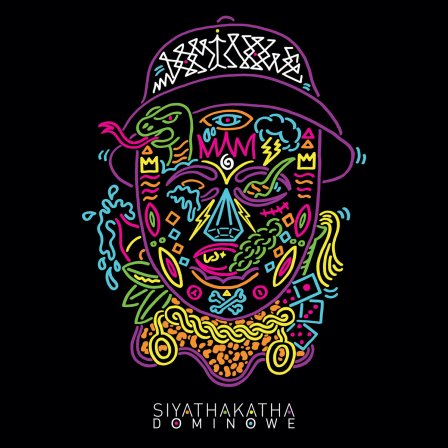“I want to tell different stories.”
– Dominowe, interviewed for FACT
As a form, gqom encourages experimentation. The particular modes it values — the elongated, trance-inducing momentums, the carefully chosen instrumentation, the foregrounding of atmosphere and affect — provide a comprehensive framework for elaboration and variation. On SiyaThakatha, his first EP for Gqom Oh!, Dominowe takes gqom’s template and runs with it. Across these eight tracks, he acts as a tour guide for the uninitiated, moving the listener through a series of styles that orbit gqom’s distinctive kick-and-drone aesthetic — core tribe, sghubu, afro house — before setting off for destinations unknown. It’s a role to which he’s well suited, as evidenced by “Africa’s Cry,” the ferocious first track from last year’s Gqom Oh! The Sound of Durban, which played a pivotal role in introducing the sounds of the Durban underground to a wider audience.
SiyaThakatha begins in media res, the tough drums and whipping winds of “Newlands Mgido” functioning as a primer in gqom’s sonic foundations. Chants, shaker, and bass sway together ominously, while drums skitter hurriedly across the track’s vast expanses — dusty fragments across desolate landscapes. Dominowe favors a modular style of composition, forgoing the bloody single-mindedness of some of his peers for a more serpentine approach, loading his tracks with appendages until they curve and bend. This practice is most ably demonstrated on “Bhenga Nezinja,” featuring Chaotic Boiz, which borrows some of house’s uplift to deliver a sghubu mini-epic. Buoyed by flute and piano, Dominowe and Chaotic Boiz guide the listener’s eyes upward as they patiently massage the track toward a simultaneous climax and breakdown. For a brief moment, some light penetrates gqom’s murk, as drums and melodies spiral off in all directions, before gravity reasserts itself and the track’s threads are knitted back together, equal parts euphoria and despair.
The ease with which Dominowe combines emotions, styles, and textures is admirable, and provides the album with some of its most compelling moments. “Tribute to Gqom Oh! (outro)” explodes into life, its psychedelic sound vibrant and wet, its hissing drums saturated by bird calls and animal cries. It’s less a gqom track than the soundtrack to the collapse of some futuristic terrarium. Here, gqom is made speculative, its sonic blueprint transformed into a map of the possible, an architecture of the non-place. Despite its truncated running time, it drips with potentiality, placing Dominowe in league with other club producers experimenting with animality-as-texture: J.G. Biberkopf, Superficie, and KABLAM.
However, there are moments when experimentation is pursued to the detriment of cohesion, resulting in overburdened, jarring fusions. “Club Killer” is the worst offender here, as Dominowe lets his enthusiasm get the better of him, cramming several songs into one unwieldy chassis. It begins promisingly: its rattling drum sound, gloomy bass, and diaphanous synth pleasingly reminiscent of Night Slugs’s club constructions. Unfortunately, after several detours, the track is reconfigured into an awkward assortment of guitars, vocal samples, and percussion. While it attests to Dominowe’s confidence as a producer and the malleability of gqom as a genre, it feels like a missed opportunity.
Despite the odd misstep, SiyaThakatha is a rich, considered work. Its sense of narrative — both within tracks and across the album — provides it with energy and purpose. It’s gqom as adventure story, travelling backwards to the genre’s roots and forwards to its possible future(s). This combination of historical awareness and speculative imagination opens up new sonic, rhythmic, and textural planes for gqom to explore. Watch this place.
More about: Dominowe


